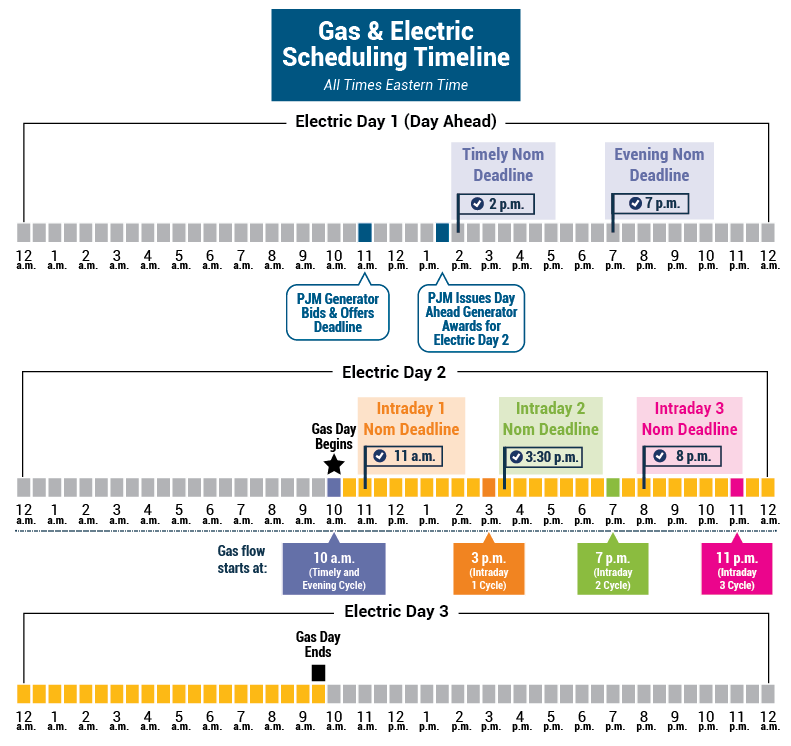How is PJM Addressing Gas-Electric Concerns?
During the 2013-2014 “Polar Vortex,” PJM experienced a stretch of extreme cold temperatures which resulted in certain gas-fired generators being unable to operate during this period. With the increasing reliance on natural gas generation, this event was the genesis of a more prominent and comprehensive gas/electric coordination effort at PJM.
In 2014, PJM established a memorandum of understanding with nine of the major pipelines which serve the PJM system and confidentiality agreements between PJM and the major pipelines, allowing for the sharing of non-public operational information.
The Gas/Electric Team
The PJM Gas/Electric Coordination (GEC) team was also formed in 2014 to increase collaboration with the natural gas industry to improve operational awareness and be better prepared in the event of gas supply disruptions which could impact grid reliability.
Key Areas of Focus:
- Daily Gas Risk Assessments: Review the interstate pipeline bulletin boards on a daily basis to assess pipeline operating conditions and identify potential fuel supply risks to the gas generation fleet. Daily reports are prepared and shared with PJM Dispatch personnel to provide operational awareness.
- Weekly Operations Review: Meet weekly during the winter months with interstate pipeline control centers to review current operating conditions.
- Outage Coordination: Meet during the non-winter months with pipeline operations staff to review and coordinate outages. The development of these relationships, along with similar relationships with many of the local gas distribution companies across the PJM system, established ongoing communication and coordination enhancements between both industries.
The development of these collaborative efforts, along with similar relationships with many of the local gas distribution companies across the PJM system has helped to better inform both industries on critical operational considerations.
The team’s coordination efforts have also expanded to include collaborative efforts with interstate pipeline company and local distribution company personnel conducting fuel security studies, tabletop exercises and operational drills. These relationships will become increasingly important as the generation resource mix evolves with the introduction of more renewable resources; this will create an even greater reliance on natural gas as a reliable and flexible fuel to meet PJM grid reliability requirements. You can learn more about fuel security in the Reports & Notices section on the PJM.com Library.
Adjusted Market Timing
In April 2016, PJM moved the release timing of its Day-Ahead Market awards from 4 p.m. eastern to 1:30 p.m. eastern. This coincided with a change by the natural gas industry to move its timely nomination deadline from 12:30 p.m. eastern to 2 p.m. eastern. The natural gas industry also added a third intraday nomination cycle at this same time to provide additional intraday gas scheduling flexibility. These changes were put into place to provide generators with more timely notification of their electric commitments and provide additional time to schedule gas in the timely cycle. Although these changes did not completely solve the continued disconnect between the electric and gas operating days, they did provide some incremental gains in the right direction. There remains the ongoing difference in operating days as the electric day runs from 12 a.m. to 12 a.m. while the gas day runs from 10 a.m. to 10 a.m.

Note: Nom = Nomination.
Collaboration Enhancements
PJM conducts an annual generation owner fuels survey in which key fuel- and emissions-related operating data is collected. This survey provides the most up-to-date fuel-related information for the generation fleet. As part of this survey, the PJM GEC team identifies key attributes for the gas-fired generators which includes contractual information for both transportation and supply, dual fuel capabilities and identification of all pipelines serving each generator. This information plays an important role during ongoing fuel risk assessments.
As challenges remain in the gas/electric coordination space, PJM continues to collaborate extensively with its own stakeholders as well our peers across the industry through the ISO/RTO Council (IRC) Electric Gas Coordination Task Force and the Eastern Interconnect Planning Collaborative’ s (EIPC) Electric Gas Task Force. Through these task forces, PJM is engaging with gas industry trade organizations such as the Interstate Natural Gas Association of America (INGAA) and the Natural Gas Supply Association (NGSA) and American Gas Association (AGA) to discuss industry best practices. PJM also has been working with both FERC and NERC on various regulatory and policy initiatives involving fuel security and industry coordination efforts from an operational as well as a long-term planning perspective.